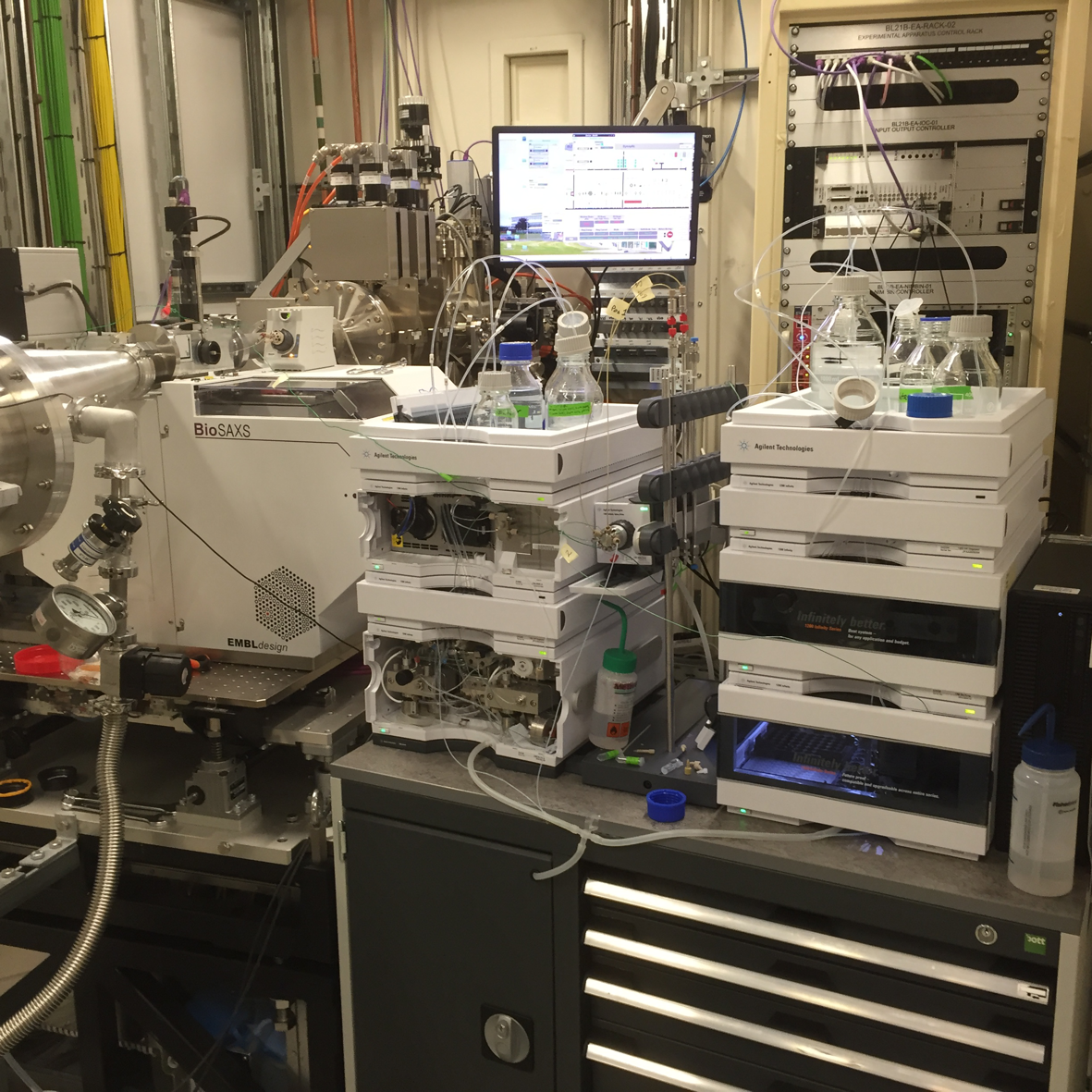________________________________________
Industrial Liaison Group:
Tel: +44 (0) 1235 778797
E-mail: [email protected]
____________________________________
Small angle X-ray scattering (SAXS) from biological macromolecules such as proteins (also called bioSAXS) gives information on the size and shape of macromolecules in solution and can provide details of the radius of gyration and molecular weight of a protein complex (e.g. multi sub-unit complexes), significant conformational changes upon ligand binding, screening of structural changes with formulation conditions (e.g. pH, ionic strength, additives, temperature etc) and many more applications.
The high intensity X-rays available at a synchrotron provide significant benefits over lab-based instruments.
Firstly the high intensity of the X-rays at a synchrotron means that measurement times are much faster, allowing structural investigation of macromolecule solutions under relevant conditions, for example at different temperatures. SAXS at Diamond can provide reliable access to second or shorter time scales, essential for understanding protein solution structures and to minimse the impact of radiation damage. Information can be obtained on the shape and size of proteins and macromolecules which may not be possible using other techniques. Small beam sizes mean that only small volumes (35µL) are required for measurements.
Shorter measurement times also result in increased sample measurement and high throughput is a key advantage of synchrotron bioSAXS measurements. A BIOSAXS robot available on B21 uses 96 well plates which can be chilled until needed for measurements ensuring high quality samples. The shorter measurement times also allow SAXS to be performed in conjunction with other techniques (for example size exclusion chromatography, SEC) called SEC-SAXS where online protein purification ensures high purity samples and ideal buffer matching.
Secondly, the greater X-ray intensity allows bioSAXS measurements to be performed at a greater separation between the sample and the detector, which allows access to a much wider range of length scales (particularly for larger length scales) than achievable using a lab instrument.
There are a vide variety of applications for macromolecular SAXS experiments but popular bioSAXS applications include:
Flexible proteins:
Macromolecular complexes
Ligand binding
 Diamond has a dedicated solution state Small Angle X-ray Scattering (SAXS) beamline that can accommodate a wide variety of aqueous-based and some limited organic solvent-based samples. In order to achieve high sample through put, B21 is equipped with a highly automated BIOSAXS robot for small volume liquid handling from a 96 well plate.
Diamond has a dedicated solution state Small Angle X-ray Scattering (SAXS) beamline that can accommodate a wide variety of aqueous-based and some limited organic solvent-based samples. In order to achieve high sample through put, B21 is equipped with a highly automated BIOSAXS robot for small volume liquid handling from a 96 well plate.
B21 also offers Size-Exclusion Chromatography (SEC) coupled SAXS with either Superdex or Shodex SEC columns controlled by an Agilent HPLC. SAXS samples are measured through a temperature controlled capillary. The beamline users benefit from a fast streamlined data processing and data analysis pipeline so data can be analysed during the experiment.

The COVID-19 virus pandemic caused by the SARS-CoV-2 coronavirus poses an ongoing serious global health threat that requires effective and safe therapeutics. The SARS-CoV-2 coronavirus uses its spike glycoprotein to bind to the host receptor angiotensin-converting enzyme-2 (ACE-2) and enter the body’s cells.
The receptor-binding domain (RBD) of the spike glycoprotein is the main target for neutralising antibodies as it can block the virus-host interaction and prevent the infection. The RBD is highly variable and can mutate to escape recognition by antibodies, thus reducing their efficacy and increasing the risk of resistance.
Moreover, the RBD is only exposed transiently on the spike glycoprotein, making it difficult for antibodies to access and bind to it. Novel antibodies are needed that can recognise and neutralise the RBD of SARS-CoV-2 with high potency and stability, regardless of its variability and accessibility
Read more...
The ability to modulate drug delivery at therapeutically effective doses over a sustained period of time, in vivo, is very challenging. In the case of poorly water-soluble drugs this requires a carefully designed matrix to manage and maintain their controlled release.
Lipid cubic phase carriers offer an effective way to transport both small molecules and larger proteins through oral and parenteral routes (those outside of the digestive tract), as well as local delivery via subcutaneous and intramuscular routes. Complex interactions between the drug and the lipid matrix govern the release profile; for hydrophilic drugs, release can be very fast. The carriers can also be compromised by naturally occurring lipolytic enzymes which act to break down the lipid microstructure.
Read more...
With 27% of global energy consumption occurring in the residential sector, harvesting and storing thermal energy is increasingly important.
A promising technology is based on phase-change materials (PCMs) that absorb or release large amounts of heat when they change state, e.g. from solid to liquid.
PCMs incorporated into building materials could remove excess heat during the day and release it at night, with minimum carbon emissions. One approach in stabilising PCMs for use is nanoscale confinement in core-shell structures.
Medicinal products extracted from biological sources, called biopharmaceuticals or biologics, must be carefully produced to ensure that only high purity active material is generated. Biopharmaceutical manufacturing processes can have an impact on the amount of product-related variants in the final clinical material. Understanding and controlling amounts of these product-related variants is a major challenge in the development of biopharmaceutical products.
Read more...
Elastin allows tissues in humans and other mammals to stretch and return to original shape e.g. during respiration or heart beats. The schematic on the right shows how many tropoelastin monomers (blue) can selfassemble and cross-link (red) to form elastin but the structure of the soluble precursor of elastin, tropoelastin, is not well understood.
Read more...Diamond Light Source is the UK's national synchrotron science facility, located at the Harwell Science and Innovation Campus in Oxfordshire.
Copyright © 2022 Diamond Light Source
Diamond Light Source Ltd
Diamond House
Harwell Science & Innovation Campus
Didcot
Oxfordshire
OX11 0DE
Diamond Light Source® and the Diamond logo are registered trademarks of Diamond Light Source Ltd
Registered in England and Wales at Diamond House, Harwell Science and Innovation Campus, Didcot, Oxfordshire, OX11 0DE, United Kingdom. Company number: 4375679. VAT number: 287 461 957. Economic Operators Registration and Identification (EORI) number: GB287461957003.